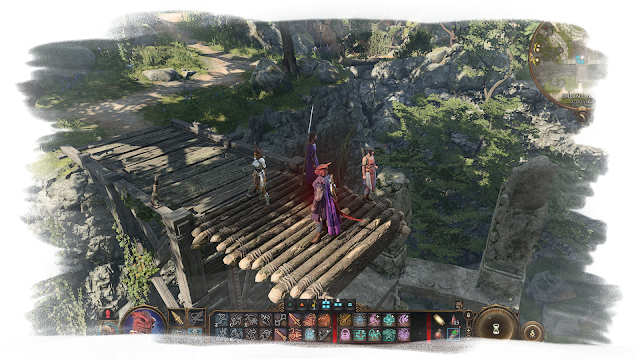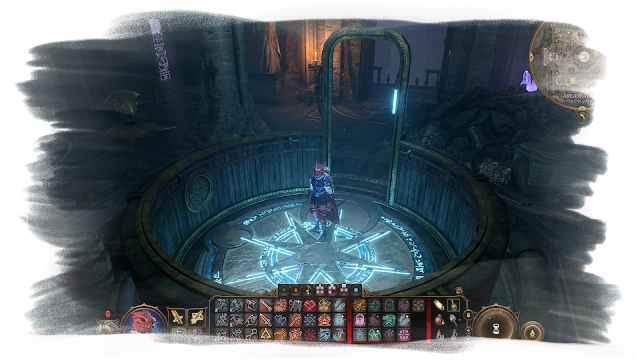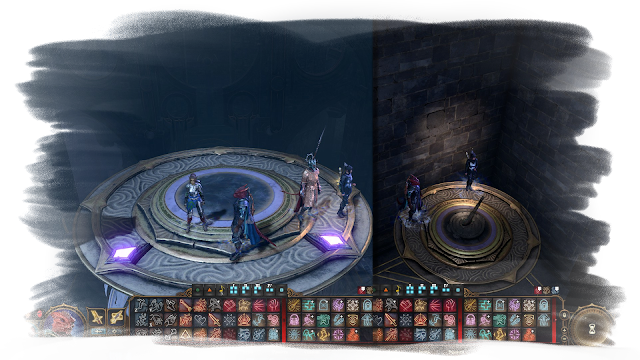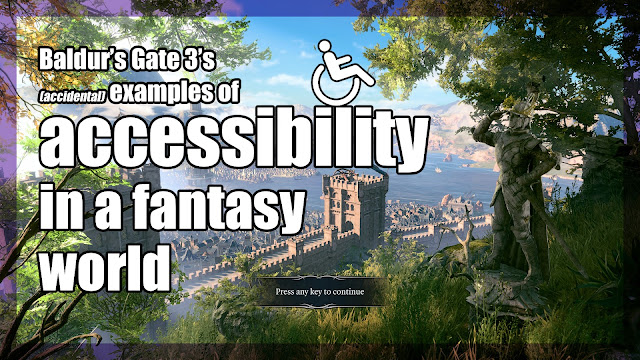Baldur’s Gate 3’s (accidental) examples of accessibility in a fantasy world
However, realism and historical accuracy is typically not why most people turn to D&D and other similar games. Last I checked, real life medieval Europe didn’t have flying lizards who could shoot magic from their faces and sentient robot men, so personally, I see no harm in adding a stone slab next to the stairs inside the dungeon hiding a lich who survived off a strict soul-only diet for 1,000 years.
However, if you’ve spent any time in TTRPG spaces online as a disabled person - or even someone who’s just playing a disabled character, you have very likely come across the argument that wheelchair using player characters shouldn’t be allowed, because making the setting accessible for them would be too distracting and immersion-breaking.
While this is not the only reason these people tend to argue against the use of wheelchairs by player characters in TTRPG’s, it is one I have found especially odd, especially since the release of Baldur’s Gate 3.
Baldur’s Gate 3 is a video game based in D&D's Faerûn setting, to which it sticks to fairly loyally. It was a wildly successful game, and I personally have absolutely adored every moment of it.
But one thing I noticed is that the people who cried about the idea of settings in TTRPG’s being made wheelchair accessible because it would be too distracting, out of place and immersion-breaking have been suspiciously quiet about the examples of those same accessibility tools being present in Baldur’s Gate 3.
Don’t get me wrong, I’m not saying the whole game would be accessible to a wheelchair using player, far, far from it, but ramps and even elevators appear throughout the game in several locations, and despite the protests aimed at their inclusion in actual D&D, hardly anyone noticed. At least, no one that I’ve seen has mentioned it.
Ramps appear in several places around Baldur’s Gate - the city the game is named after and the final region of the game. Most notably around the docks.
 |
| [ID: A picture within the city of Baldur's Gate. Characters are standing around a dead tree looking towards a set of stairs, half of which have been covered by a sturdy looking wooden ramp. /End ID] |
Another few can be found in Waning Moon inn, a tavern overrun with undead, not far from Moonrise Towers. The ramps, while honestly hilariously steep, connects the 1st and second floors.
 |
| [ID: Two screenshots displayed side-by-side showing steep ramps built within a run-down, abandoned inn. /End ID] |
There are also multiple elevators located throughout the game, most notably a wooden one that is being blocked by a sleeping bear in the druid’s grove, right at the start of the game.
 |
| [ID: A screenshot showing an elivator consisting of an old, wooden mechanism acending a wooden structure. /End ID] |
Another can be found at the centre of the Arcane Tower in the Underdark
 |
| [ID: A character is standing on a circular, glowing platform located inside a tube-like structure with a door behind the character. /End ID] |
and several more can be found in the Temple of Shar in The Shadow Cursed lands: one by the entrance to the temple itself, one that takes you from the end of The Gauntlet of Shar back to the start, and one that takes you down to the inner sanctum of the temple.
 |
| [ID: Two more screenshots side-by-side show characters standing on another pair of circular elevator platforms, these two are intricately decorated, and ascend and descend by floating. /End ID] |
Now, I know that Larian Studios didn’t include these features for the sake of making their world accessible to wheelchair users. Many of the ramps are located in places that indicate they were to aid carts and carriages moving supplies. The one in The Waning Moon Inn even has some kind of track built into it. The elevators are all also placed in locations where players would likely be backtracking a lot, and seem to mostly be present for our convenience.
But whether this was Larian’s intention or not is irrelevant to the point in my opinion.
While these locations are not fully wheelchair accessible, Baldur’s Gate 3 showed, quite publicly, that it can be done and be lore-friendly, that it won’t break people’s immersion and be “obvious pandering”. the key thing is though, the locations have to be designed with those features in mind from the start. If you make a normal medieval tavern and just replace the stairs with a ramp, it will look out of place. If you try to make elevators that look like the modern day version, it’s going to look out of place, but it doesn’t take much of a change to make either work.
A druid’s grove most likely won’t make an elevator that looks like the modern version we have today, but a big moving, wooden platform operated by a hand crank? That seems much more in-line with their aesthetic. The Waning Moon’s layout wouldn’t look the same if you just plopped a set of stairs down instead of the ramp, because it was likely designed with the extra space something like that would need in mind.
Unfortunately, even in the modern day, the inclusion of things like ramps and lifts are often not really considered in the design of buildings. not fully. This is why a lot of real-world examples, admittedly can sometimes look kind of weird and out of place, especially on older buildings. However, well crafted accessibility options don’t have to stand out. When done well, they are as much a part of the architecture and building or location's design as other features like stairs can be and I think Baldur’s Gate 3 is a great - if accidental - example of how it can look in a fantasy setting and be seamlessly integrated into the world when done right.
When designing a fantasy setting, whether for D&D and other TTRPG’s, for a book, for a comic or whatever else you’re making, remember that just because that’s how it was in real life, doesn’t mean that’s what it has to be like in your setting. The real-life dungeons were just prisons, but TTRPG’s have taken the concept and turned them into these labyrinths filled with puzzles, traps, monsters and treasure. Real-life medieval Europe, for the most part, didn’t allow women to do a lot of things we see modern-day fantasy characters doing, regardless of gender. There are so many commonly accepted differences between the real-life medieval period and fantasy, why can’t an accessible world be one of them too?

Comments